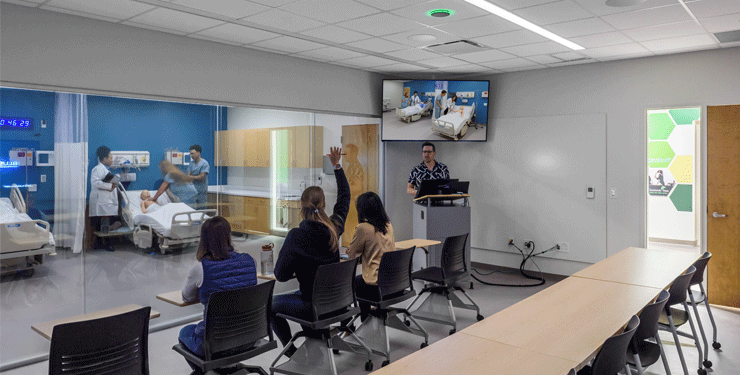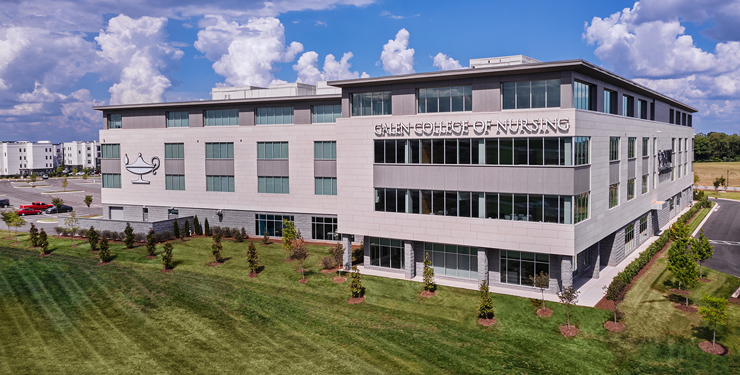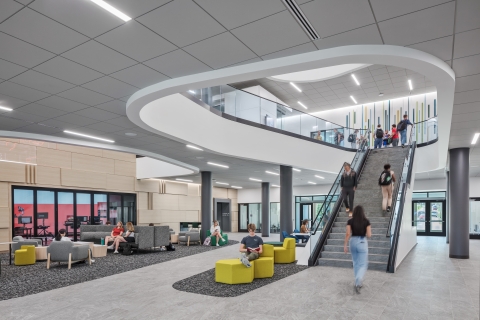
From Simulation to Reality: How Design Impacts Nursing Education and Practice
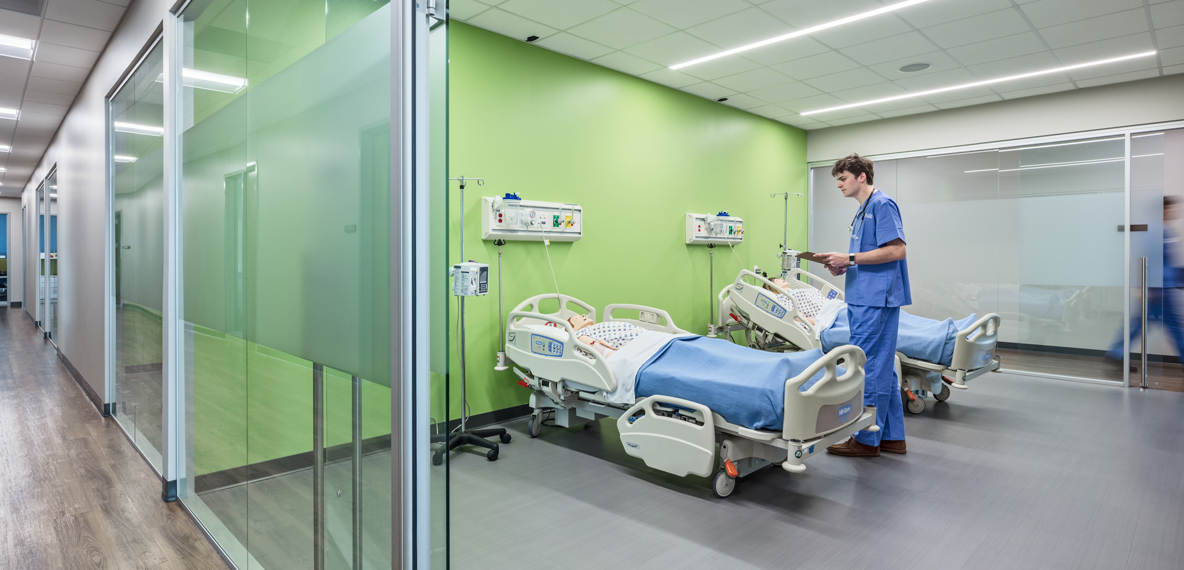
The U.S. faces a critical nursing shortage, and early-career turnover is a key challenge. At Ballad Health, for example, data shows that 50% of their nurse turnover involved individuals within their first two years on the job, according to Nurse.org. This trend reflects a broader national concern: new nurses often feel unprepared for the demands of clinical practice, leading to burnout and early exits from the profession.
Simulation-based education excels at bridging this readiness gap. Realistic simulation training boosts clinical confidence, decision-making, and retention by allowing students to build real-world skills in a controlled environment. But the success of simulation isn’t just about technology; it’s also about the space.
In this blog, we explore how intentional design can elevate simulation training. During a recent visit to Galen College of Nursing’s Louisville Simulation Center, we gained valuable perspectives through conversations with leadership, faculty, and students. Their experiences shed light on how thoughtful space planning, paired with simulation-based education, can better prepare the next generation of nurses for long, rewarding careers in healthcare.
Inside Galen’s Louisville Simulation Center: Key Takeaways
Since 2017, BHDP has maintained a strategic design partnership with Galen College of Nursing to help shape a consistent, forward-thinking brand and learning experience across its expanding network of campuses. As part of this collaboration, we developed a clinical education prototype to guide Galen’s national growth, resulting in over 1,000,000 SF of nursing school environments across 24 cities in the South, Southeast, and Western US.
In 2019, BHDP designed the Louisville Simulation Center, one of the first implementations of this prototype. In April 2025, I toured the facility with Janeen Berndt, DNP, ACNS-BC, CNE, CHSE, FAADN, Galen’s Senior Director of Curriculum and Instruction, to better understand how the space is performing today. The purpose of the visit was to gather firsthand insights into what’s working, what could be improved, and how intentional design continues to impact student outcomes. From this conversation and immersive walkthrough, the following key best practices emerged for designing simulation environments that truly support the development of confident, capable future nurses.
- Design for a Snapshot, Not a Shift: The most effective simulation experiences focus on replicating a single procedure or medical event—a “snapshot” of a nurse’s day—rather than simulating a complete hospital shift. Clinical rotations offer broader hospital exposure; simulation should be targeted and intentional.
- Establish Psychological Safety as a Basic Tenet: High-fidelity simulation is effective because it engages the brain's emotional processing center. Thus, the simulation experience should be positive rather than negative. Students must feel safe trying new procedures, making mistakes, and building confidence. Being watched by others outside of the simulation experience can create a negative emotional experience. If windows are part of the design aesthetic, ensure the glass is frosted or blinds are utilized to minimize any potential “fishbowl” effect.
- Balance Simulation, Debriefing, and Control Rooms: The ideal ratio of simulation rooms to debriefing rooms is 1:1. Debriefing is a critical part of the learning process, offering time and space for reflection, discussion, and skill reinforcement immediately after each scenario. While it’s possible to operate simulations remotely or run multiple rooms from one control center, prioritize control room placement. The preferred configuration is also a 1:1 setup, with each control room adjacent to its corresponding simulation room equipped with a one-way mirror. This allows facilitators to observe in real time and adjust scenarios as needed.
- Design for High Throughput: Ideally, multiple entryways to the simulation room will enable faculty and staff to enter from doors closest to the storage and preparation spaces. At Galen’s new Aurora, CO, facility, BHDP developed a new high-throughput simulation center where each simulation room has a service and a simulation entry to allow technicians to set up simulations without interrupting nearby simulations.
- Provide Support Offices for Focused Faculty Work: Instructors and simulation technicians need dedicated workspaces that allow for quiet, focused time, particularly for tasks like scenario planning, documentation, and assessment.
- Avoid Traditional Nurses Stations: An efficient simulation space would have point-of-care supply rooms for patient-care supplies that are near the simulated patient room. Additionally, a medication room is an important feature to allow simulation participants to prepare medication for administration, whether from a medication dispensing system or a cart. For electronic health record (EHR) access, a computer mounted within the simulated patient room or on a cart is sufficient, as this is where nurses would typically access the EHR in a hospital.
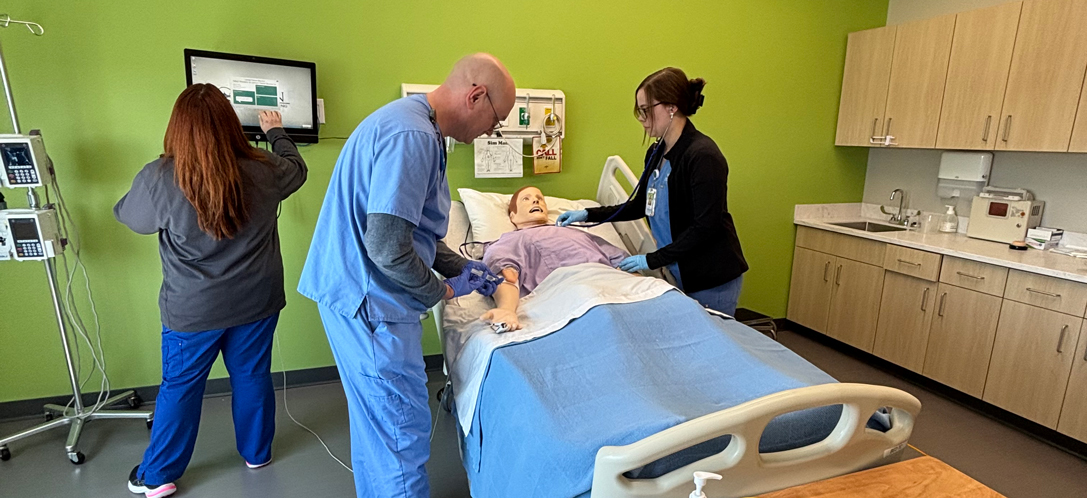
Students practicing checking vital signs and flushing an IV line on a high-fidelity simulated patient.
The User Experience: Faculty and Student Perspectives
While insights from leadership like Janeen Berndt offer valuable strategic guidance, the voices of students and faculty using the space daily are equally important. To better understand how the Louisville Simulation Center performs in practice, we conducted a focus group with three Galen faculty members and three nursing students.
The conversation began with a simple but powerful question: What inspired you to become a nurse? For many, it stemmed from deep personal experiences—a mentor who made a lasting impact or a moment of vulnerability in a hospital setting that sparked a desire to care for others. These stories underscore the weight of what simulation training is preparing them for.
Their experiences revealed what’s working, areas for improvement, and how simulation environments can evolve to better support the next generation of nurses. Here are some of their suggestions:
- Balance Visibility with Privacy: Students expressed discomfort with being observed during simulations, which echoed a key takeaway from my conversation with Janeen: creating psychological safety is essential. One student remarked, “I don’t like that people are watching, so providing a setting where I feel I’m not in the spotlight would be preferred.”
- Increase Simulation Exposure: Students crave more opportunities to experience complex or unexpected scenarios. “I want to see what can go wrong so I’m better prepared to handle it in the hospital,” one student said.
- Integrate Theory with Practice: Some students benefit from simulations before lectures to help contextualize material, while others prefer the reverse. Designing curricula with flexibility in mind supports diverse learning styles.
- Simulate Real-World Complexity: Simulations should mirror medical procedures and real-world dynamics, such as documentation, multitasking, and family communication. Incorporating sensory elements such as beeping monitors, patient voices, and medical odors enhances immersion and prepares students for the complexities of clinical practice.
- Foster Trust Through Faculty Interaction: Faculty emphasized that the goal of simulation isn’t to intimidate—it’s to build confidence. “We never try to scare our students. We make them aware of the objectives of the simulation scenario, and our job is to bring these simulations to life and allow the students to best react to them and learn from the experience,” said one faculty member.
- Design for Long-Term Future Flexibility: Consider modular, reconfigurable, multi-purpose spaces used as classrooms, virtual reality, or debriefing rooms can ensure the simulation center remains flexible, relevant, and effective long-term. The Healthcare Simulation Standards of Best Practice emphasize ongoing training and development for simulation faculty and staff to ensure the educational curriculum is future-proof.
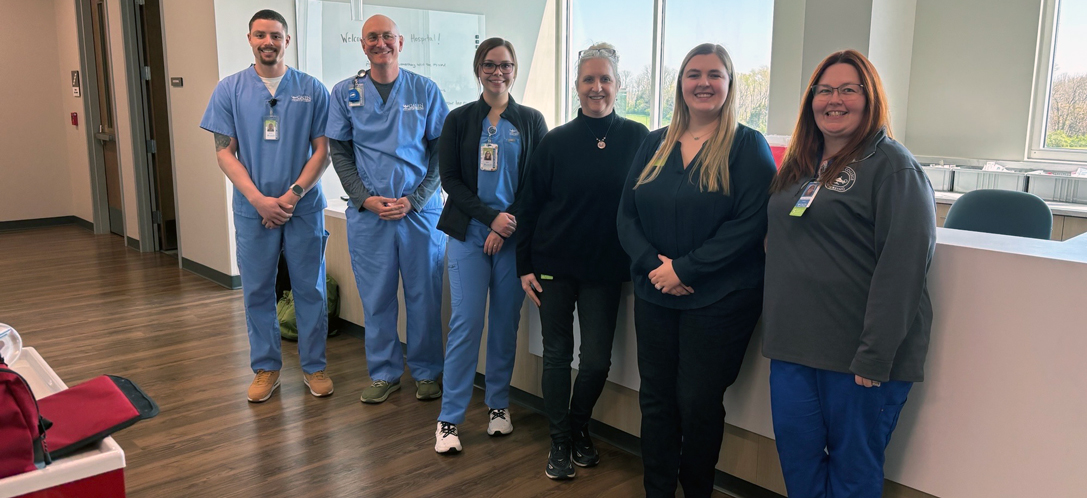
Galen College of Nursing students and faculty answered questions and provided guidance on how simulation spaces can evolve to support their needs.
Designing for Retention and Resilience
Thoughtfully designed simulation environments can replicate even the most complex, high-stress scenarios, building clinical proficiency, reducing anxiety, and fostering trust between students and instructors. When strategically planned, these spaces support immediate educational outcomes and contribute to long-term professional retention and success.
Are you interested in designing or enhancing your simulation environment? Please fill out the contact form to learn how we can help you plan for the future of healthcare education.
Author
Content Type
Date
May 07, 2025
Topic
Nursing Education
Healthcare Design


